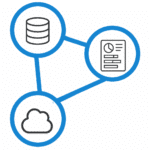
The Business Catalog is the most important part of the data governance program.
It will enable the organization of governance through role assignments, the definition of organizational policies, and the monitoring of business processes.
The Business Glossary is the heart of the program, identifying the 1,000 to 4,000 unified business information items that constitute the organization’s knowledge management. It is, therefore, the institutional memory of the company and its employees.

The Data Catalog is the easiest part of the governance program.
All descriptive elements (metadata) for storage, transformations, flows, analysis, and reporting are retrieved via native connectivity to your software.
Data lending of the information system is therefore complete, from the governance document to the production data.
Important uses of the Enterprise Catalog
Search
This is the core function of the Enterprise Catalog. Powered by AI, it provides the ability to find unified information.
Collaboration
Everyone can enrich the Enterprise Catalog through simple comments, tasks to be completed, or validations.
The DATA Products will describe the datasets made available to advanced users.
This data is therefore validated, meets a quality standard, and is shared under a DATA Contract for reuse.

The internal DATA Marketplace allows users to easily access and view data assets. They can search by classification or technology.
This includes analytics tools such as Business Objects, Qlik, Tableau, and Power BI, as well as data products and AI tools.


